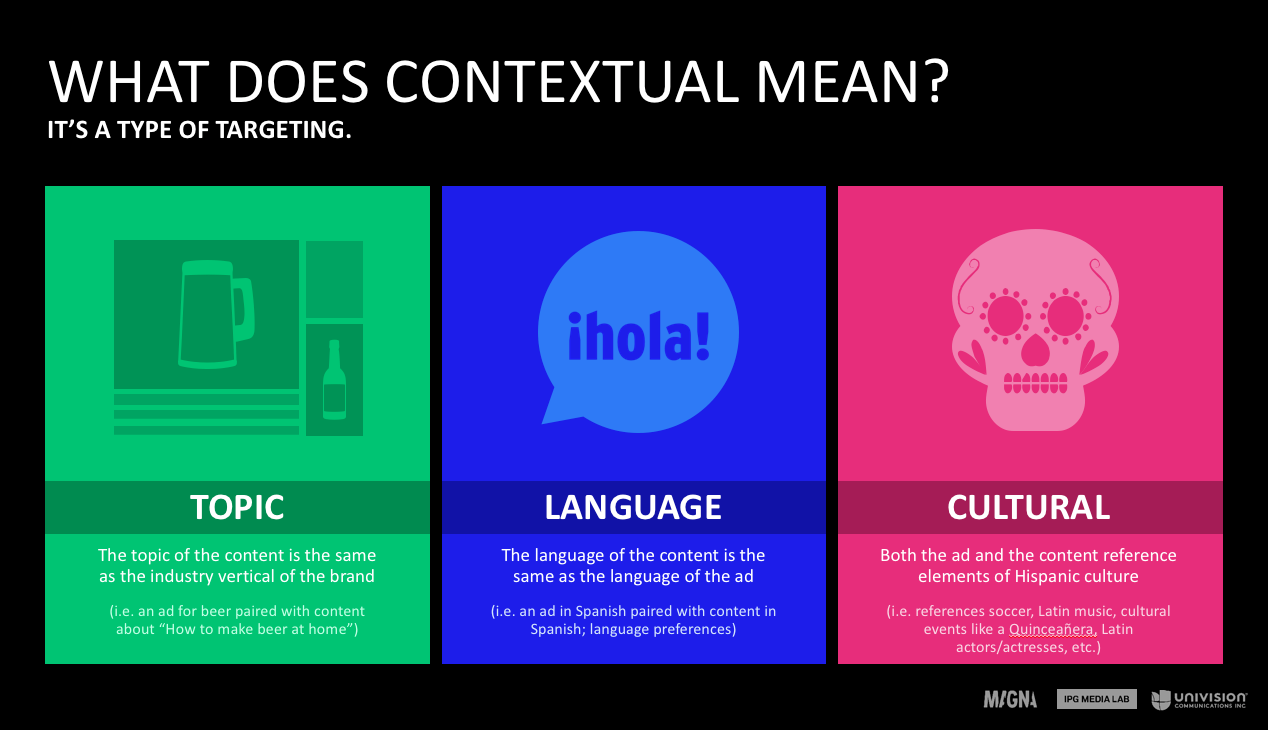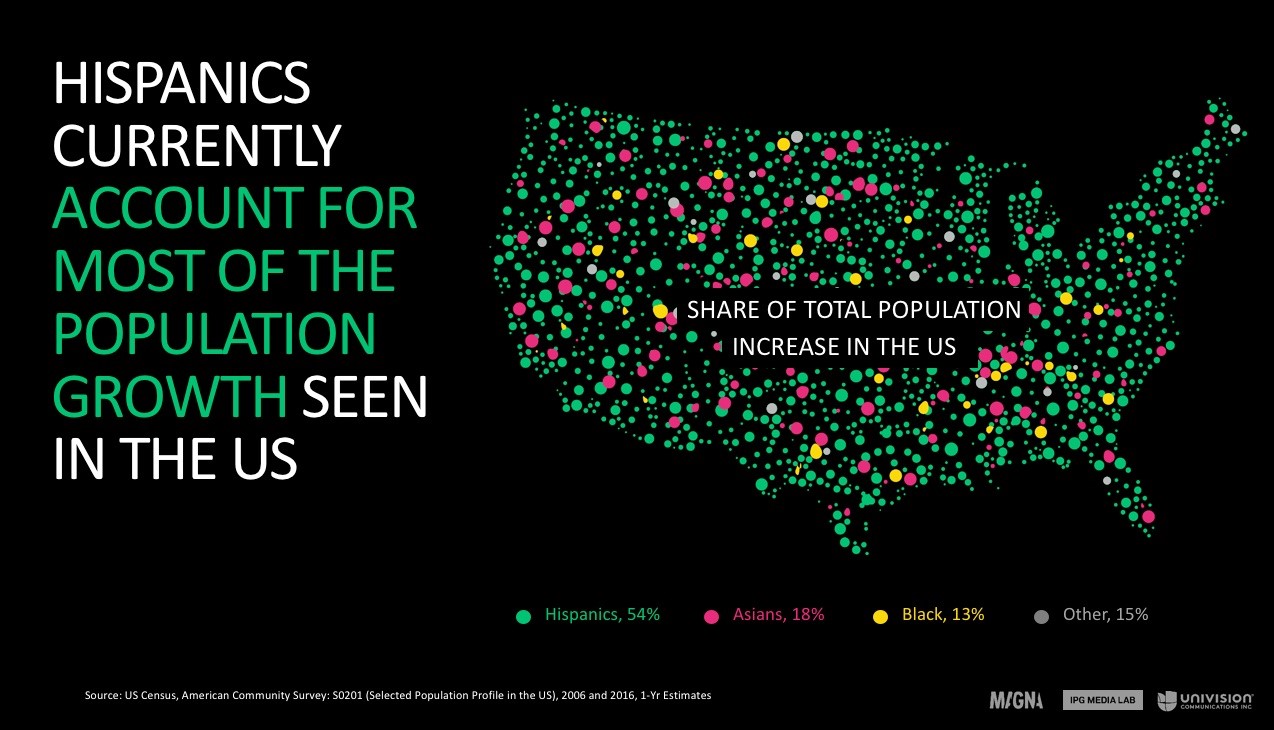Hispanic spending is projected to grow 85% over the next 10 years and reach $1.7 trillion by 2020,
which makes this market segment one of the most important consumer
targets for advertisers. But how can marketers meaningfully connect
with Hispanic consumers? MAGNA and Univision
have just released the results of a seminal research study
titled "Marketing to the Hispanic Mindset" that measures the impact of
contextual targeting (topic, language and culture) in digital video ad
experiences.
Among other key insights, the study revealed that language and
culture targeting in digital video ads can double the purchase intent of
Hispanic consumers and increase their emotional connection with brands.Surveying 6,000 Hispanic consumers, the study is the first of its kind to include mobile face-tracking in Hispanic research. "We wanted to understand the role of language and context in digital advertising, including mobile and emotional facial coding to gain deep insights," said Roberto Ruiz, Executive Vice President, Insights and Analytics at Univision.

I sat down with Ruiz and Kara Manatt, Senior Vice President, Intelligence Solutions Strategy at MAGNA to delve more deeply into how the right targeting can connect brands with the Hispanic consumer.
Charlene Weisler: Tell me how targeting can impact ad receptivity among Hispanics.
Kara Manatt: We tested three types of targeting. The first, Topic targeting -- when the topic of the ad is related to the topic of the content it appears in front of -- replicated what we tested among a general audience. An example would be content on the health benefits of owning a cat that has a pre-roll ad for a cat food brand. Obviously, there is a strong connection between the product being advertised and the editorial context in which it appears.
The second type that we explored in the study was Language targeting, which is when the language of the ad is matched to the language of the content. For example, Spanish-language pre-roll ads that run into Spanish-language video content.
Cultural targeting was the third area; that is when an ad speaks to Hispanics through culture. This can be a bit trickier to nail down since there are a lot of different ways to do that, such as through music, food and specific Latino events. In Cultural targeting you align an ad that connects on a cultural level with content that does the same thing.
Weisler: What were the major takeaways from the study?
Manatt: The key findings for us were the big differences in persuasion metrics, particularly the really important and hard-to-move metrics like brand favorability and purchase intent. Using language and cultural targeting to double purchase intent was the No. 1 key takeaway; we saw double the impact from merely changing the environment and not the ad. The other takeaway was that it helps build a relationship between the brand and the consumer. Hispanics are particularly sensitive to cultural messaging from an advertiser. They are receptive to the brand going the extra mile by speaking to them in their own language and making that cultural connection. This is not lost on the consumer. Again, notably you are not changing the ad. You are only changing the environment.

Roberto Ruiz: We also gathered a lot of data on mobile targeting. When we used the emotion tracking part of the study and we looked at the percentage lift in emotion due to cultural targeting versus no targeting, we saw that with cultural targeting there was more emotion expressed by the people watching the ad. So, the fact that cultural targeting had a huge impact in emotion on ads received via computers and mobile -- in mobile we saw 60% more emotion being expressed by the Spanish dominant and bi-lingual Hispanics -- told us that cultural targeting is creating a visceral connection and driving emotion. We know that in branding, emotional connection is really what drives equity.
Weisler: Were there any surprises in the results?
Manatt: It's not often we find that what is good for the brand is something that is also good for the consumer. It is good for brand metrics, but it also leads to a better overall media experience for the consumer.
Ruiz: It surprised me that Language targeting and Topic targeting performed the best on smartphones. There is so little data on how to create effective mobile ads that I thought this finding was very interesting.
Weisler: What are your recommendations to advertisers?
Ruiz: We say that these are building blocks -- each step leads to a deeper and more profound relationship to the consumer. Don't limit yourself to Topic targeting and Language targeting. Take it all the way to Topic, In-Language and Culture to have very powerful digital ads. You will see the brand KPIs go up. This research surveyed 6,000 consumers -- a large study with a representative sample that includes non-self-reported data (data that was collected by an app) and that builds on these three targeting steps. You can see the lift from each one. But if brands want to do cultural targeting they have to do their homework. They have to understand the consumer insights that connect the brand to the category, to the consumer and create a solid, culturally targeted creative ad.
This article first appeared in www.MediaVillage.com
No comments:
Post a Comment